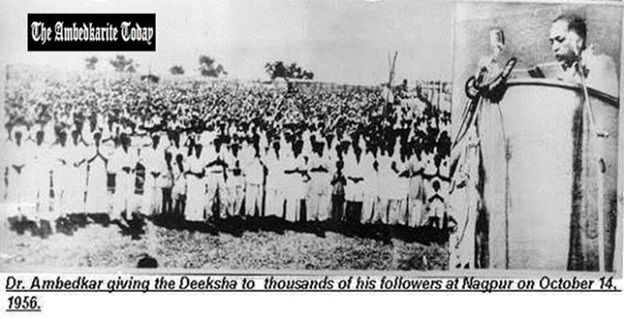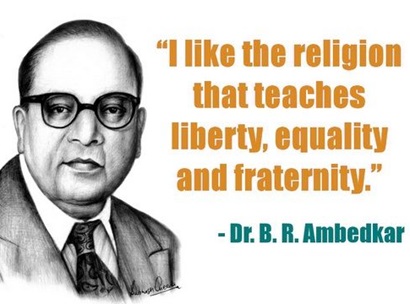Babasaheb’s Conversion
Relevance
- GS Paper 1 Modern Indian History from about the middle of the eighteenth century until the present- significant events, personalities, issues.
- Tags: #Ambedkar #Untouchablility #castesystem #IndianExpressEditorial #UPSC
Why in the News?
On October 14, 1956, Dr. B.R. Ambedkar, a key architect of the Indian Constitution and a champion of the Depressed Classes, made a historic decision to renounce Hinduism and convert to Buddhism. This pivotal moment marked his journey towards addressing the deeply entrenched issues of caste and social discrimination in India.
BR Ambedkar’s Conversion to Buddhism: A Landmark Event
- On October 14, 1956, just seven weeks before his passing, Dr. B.R. Ambedkar, the architect of the Indian Constitution and a leader of the Depressed Classes, made a momentous decision to convert to Buddhism.
- Alongside his wife and hundreds of thousands of people from across the nation, they were initiated into Buddhism by revered Burmese monk Bhikkhu Chandramani.
- The venue, now known as Deekshabhoomi in Nagpur, stands as a significant pilgrimage site for neo-Buddhists.
Ambedkar’s Pledge to Abandon Hinduism in 1935
- On October 13, 1935, at a gathering of over 10,000 people in Yeola, Nashik district, Maharashtra, Dr. B.R. Ambedkar, born a Hindu, made a heartfelt declaration.
- He vowed not to live in the demeaning conditions imposed by Hinduism, expressing that he had no control over his birth but would not accept its humiliating practices.
- In an emotional hour-and-a-half address, he concluded firmly, “I solemnly assure you that I will not die a Hindu.”
- This pledge ultimately led to his conversion to Buddhism 21 years later.
Gandhi and Ambedkar’s Evolving Differences Post-Poona Pact
- Despite the Poona Pact, a political agreement for political representation for the Depressed Classes within the Hindu society, Mahatma Gandhi and B.R. Ambedkar continued to diverge ideologically.
- In early 1946, Ambedkar spoke in Sholapur, revealing that Gandhi had refused to meet him.
- Gandhi’s reason, as stated by Ambedkar, was that their perspectives were too dissimilar.
- This emphasized the growing divide between the two leaders, with their earlier political deal unable to bridge their deepening ideological differences.
Gandhi’s Appeal to Ambedkar after Religious Conversion
- Following B.R. Ambedkar’s decision to convert to Buddhism, Mahatma Gandhi was deeply concerned.
- He described Ambedkar as “high-souled” and “highly educated” and encouraged him to reconsider.
- Gandhi believed untouchability was on the decline and urged Ambedkar to evaluate his ancestral religion, Hinduism, based on its merits rather than the actions of unfaithful followers.
Ambedkar’s Disagreement with Gandhi on Hinduism
- Ambedkar held a fundamentally different view from Gandhi regarding untouchability and Hinduism.
- While Gandhi attributed the issue to the actions of faithful followers, Ambedkar believed it stemmed from Hinduism’s teachings.
- He argued that as long as caste and varna persisted, untouchables could never achieve true freedom.
- In a speech in May 1936, Ambedkar emphasized that the struggle between “Caste Hindus” and “untouchables” was an enduring issue, given the inherent inequalities within Hinduism.
- Ambedkar strongly cautioned against Gandhi’s attempts to integrate the Depressed Classes, referred to as “Harijans,” into the Congress, viewing it as a trap to be avoided.
Ambedkar’s Opposition to Gandhi – A Strong Message to the Depressed Classes
- In a significant speech at the All-India Depressed Classes Conference in Nagpur on July 18-19, 1942, Ambedkar explained his reasons for opposing Gandhi.
- The conference had begun drawing large crowds, with over 75,000 people in attendance.
- The increasing numbers of the Depressed Classes in the British Army and administration were indicative of their growing influence.
- Ambedkar emphasized that this progress was not due to Hindu benevolence but a result of their own efforts.
“Annihilation of Caste”
- Ambedkar’s struggle for the rights of the Depressed Classes extended beyond mere political power.
- His groundbreaking work, “Annihilation of Caste,” played a pivotal role in challenging the caste system in Hinduism.
- Originally intended as a speech for the Jati Pati Todak Mandal’s event in Lahore, it was deemed too controversial due to Ambedkar’s harsh critique of the Vedas and other Hindu scriptures in the context of the chaturvarna system.
- Consequently, the event was canceled, prompting Ambedkar to publish the essay as a book.
- In “Annihilation of Caste,” Ambedkar passionately condemned the caste system’s inherent injustices and advocated for its complete eradication.
- He emphasized that political power was crucial for securing the rights of the Depressed Classes.
- This work underscored Ambedkar’s unwavering commitment to dismantling the oppressive caste hierarchy in India.
Ambedkar’s Unwavering Stand Against the Caste System
- Ambedkar strongly condemned the caste system, labeling it a “planned misfortune.”
- He expressed his willingness to lead the effort to dismantle it if Hindus were committed to the cause, even if it meant forsaking their kin and religious beliefs.
- He believed that mere inter-caste dining or marriages couldn’t eradicate caste because it was a deep-rooted mindset and a “disease of the mind.”
- Ambedkar patiently waited for two decades to see if Hindus would embrace his proposal for dismantling the caste system.
- Several caste Hindus eventually joined him in conversion at Deekshabhoomi.
Ambedkar’s Justification for Conversion to Buddhism
- Ambedkar framed his conversion as a rebellion against the unjust Hindu social hierarchy.
- He emphasized that concepts like liberty, equality, and fraternity were not foreign ideals but core teachings of his master, Buddha.
Revisiting Ambedkar’s Journey Amidst the Resurgence of Caste in Politics
Ambedkar maintained that rejecting the caste system required endorsement from a religious authority within Hinduism due to its divine status. While there were some developments in the late 1960s when Hindu saints proclaimed the unity of all Hindus, the caste and varna systems persist, reinforced by political pragmatism and religious traditionalism instead of complete rejection as advocated by Ambedkar.
|
Dr. B.R. Ambedkar: A Champion of Equality
|
Source: Indian Express
Mains Question
Discuss the significance of Dr. B.R. Ambedkar’s conversion to Buddhism at Deekshabhoomi in Nagpur in 1956. How did his views on caste and Hinduism influence this decision, and what impact did it have on India’s social and political landscape?





